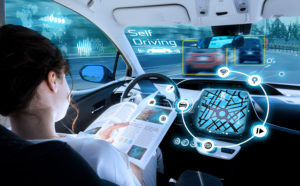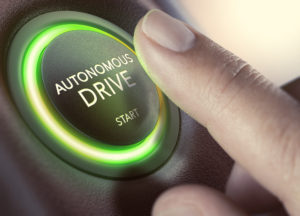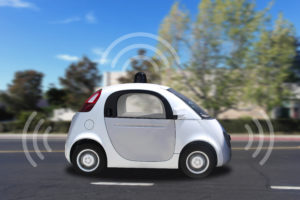
Researchers for the AAA auto club say active driving assistance systems for cars caused some type of issue for motorists about every 8 miles of driving in road testing and “are far from 100% reliable.”
It appears that roadways filled with self-driving cars that will help us avoid car accidents remains just a dream for now.
“AAA has repeatedly found that active driving assistance systems do not perform consistently, especially in real-world scenarios,” Greg Brannon, AAA director of automotive engineering and industry relations, says in a news release. “Manufacturers need to work toward more dependable technology, including improving lane-keeping assistance and providing more adequate alerts.”
What AAA Found Testing Driver Assist Technology
AAA tested Level 2 driving automation systems available to the public in five manufacturers’ vehicles in “real-world driving” as well as closed-course testing.
Level 2 on a scale of six (0-5) created by SAE International is the highest level of automated vehicle technology commercially available today.
The AAA study examined active driving assistance (ADA) systems, which combine braking, acceleration and steering, adaptive cruise control, and lane-keeping assistance. By contrast, other systems available today are classified as Advanced Driver Assistance Systems (ADAS) and include things like blind-spot warning, adaptive cruise control, and automatic emergency braking.
ADA technology actively assists the driver, while ADAS only engages when needed. With either technology, the driver must remain engaged and perform driving tasks.
In closed-course testing, ADA systems generally performed as described in their owner’s manuals, the AAA study report says. But on the open road, test drivers reached a consensus that over approximately 4,000 miles of driving distance, the systems tested did not significantly enhance the driving experience for the majority of scenarios.
On closed courses:
- Each evaluated system was able to maintain consistent lane positioning.
- In simulated stop-and-go scenarios, each test vehicle successfully stopped, making no contact with the lead vehicle.
- When approaching a simulated disabled vehicle, a collision occurred 66% of the time and the average impact speed was 25 mph. Most owner’s manuals explain that the systems have trouble spotting stationary objects, AAA says.
On public roadway tests:
- Nearly three-quarters (73%) of errors involved instances of lane departure or erratic lane position. “Researchers noted instances of the system having trouble keeping the vehicles being tested in their lane and avoiding close contact with other vehicles or guardrails,” the news release says.
- On average, researchers recorded a noteworthy disruption approximately every 8 miles, totaling 521 events.
AAA researchers said the ADA systems that combine vehicle acceleration with braking and steering often disengage with little notice – almost instantly handing control back to the driver. “A dangerous scenario if a driver has become disengaged from the driving task or has become too dependent on the system.”
 “Active driving assistance systems are designed to assist the driver and help make the roads safer, but the fact is, these systems are in the early stages of their development,” Brannon, the AAA director of automotive engineering, says in the news release. “With the number of issues we experienced in testing, it is unclear how these systems enhance the driving experience in their current form. In the long run, a bad experience with current technology may set back the public acceptance of more fully automated vehicles in the future.”
“Active driving assistance systems are designed to assist the driver and help make the roads safer, but the fact is, these systems are in the early stages of their development,” Brannon, the AAA director of automotive engineering, says in the news release. “With the number of issues we experienced in testing, it is unclear how these systems enhance the driving experience in their current form. In the long run, a bad experience with current technology may set back the public acceptance of more fully automated vehicles in the future.”
The release says further that AAA’s 2020 automated vehicle survey found that only 12% of drivers would have trust in a self-driving car. “To increase consumer confidence in future automated vehicles, it is important that car manufacturers perfect functionality as much as possible before deployment in a larger fleet of vehicles,” it says.
The Impact of Driver-Assistance Technology on Negligence Law
Industry experts and even the National Highway Traffic Safety Administration (NHTSA), the federal government’s auto safety and regulation agency expect that self-driving vehicles will eventually become commonplace on U.S. roadways.
It’s just as safe to predict that self-driving vehicle accidents will continue as self-driven traffic increases. A June 2020 study from the Insurance Institute of Highway Safety (IIHS) predicts that, at best, autonomous vehicles may one day eliminate about a third of car crashes.
When autonomous car accidents cause injury and death, those who are harmed – drivers (of either vehicle involved in a collision), passengers, pedestrians, bicyclists – will have a right to seek compensation. The parties that may be held liable after a self-driving car crash include the:
- Car manufacturer
- Maker of automation component parts
- Person who was in the driver’s seat but not actually driving.
Investigations into claims will look to determine whether the automation system failed and/or how much control the operator had or should have had over the vehicle at the time of the accident. For the driver or passenger injured in an autonomous car, the question becomes whether the manufacturer disclosed the potential for failure well enough for the reasonable person to understand the risk.
One oft-cited analogy compares driverless cars to riding horses. Both modes of transportation can perceive their environment and travel semi-independently, but they can also misunderstand their surroundings and make dangerous maneuvers independent of the human operator’s will.
How an Indiana Car Accident Lawyer Can Help
 The law surrounding automated driving will evolve as the technology becomes more commonplace, including personal injury and tort law. If the day comes that you are involved in a car accident caused by automated driving systems, you’ll need to consult lawyers who are experienced in car accident claims and who have the resources to investigate accidents involving new automotive technology.
The law surrounding automated driving will evolve as the technology becomes more commonplace, including personal injury and tort law. If the day comes that you are involved in a car accident caused by automated driving systems, you’ll need to consult lawyers who are experienced in car accident claims and who have the resources to investigate accidents involving new automotive technology.
In Indiana, contact Craig, Kelley & Faultless LLC online or at (800) 746-0226 about a car accident case. Since being established in 1999 by three attorneys dedicated to helping personal injury victims, the law firm has grown to become a team of hard-working, highly trained attorneys and legal staff with the resources and readiness to fight for you to obtain results through our civil justice system.




 Email
Email Facebook
Facebook Twitter
Twitter